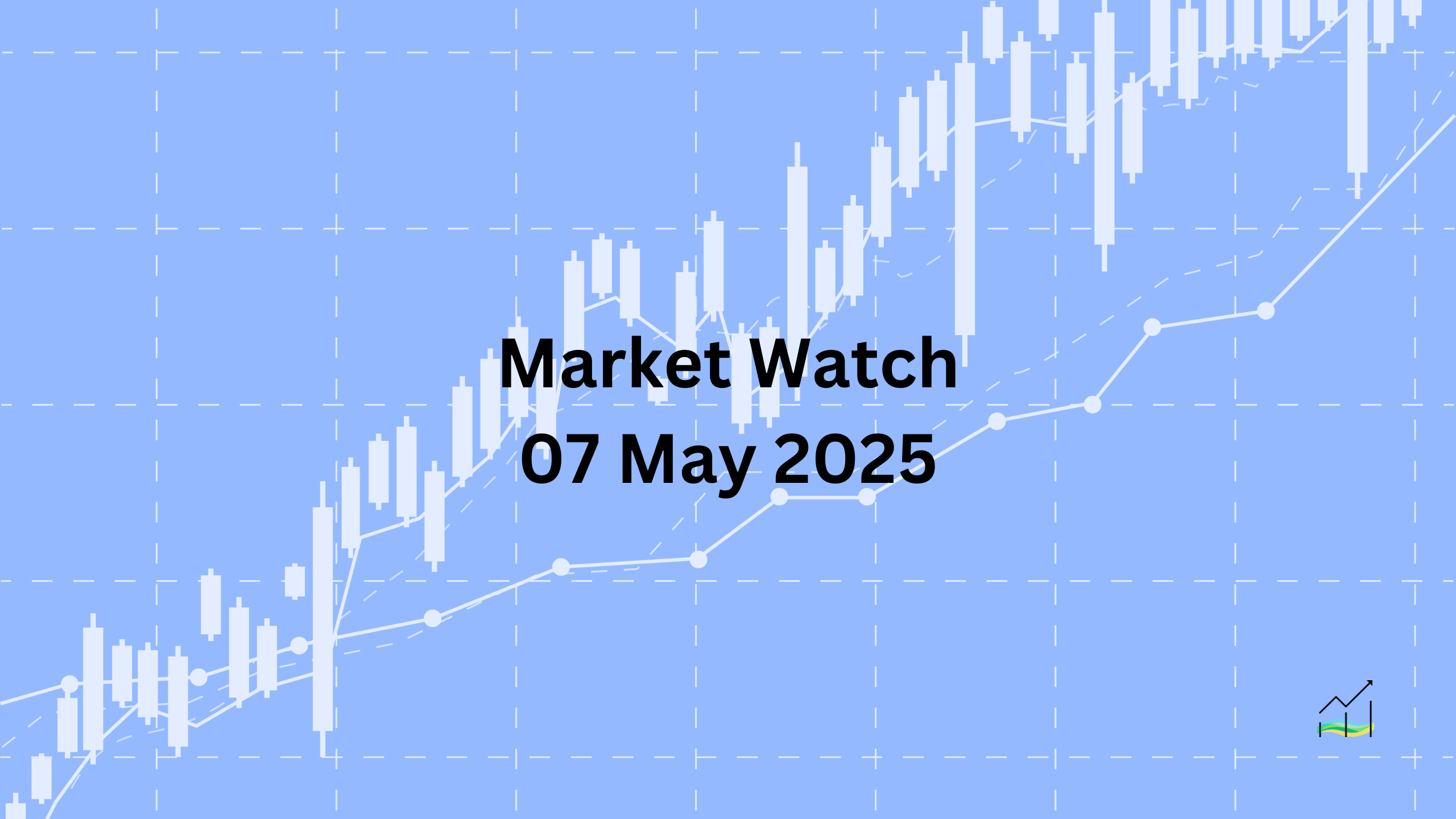07/05/2025 Market Watch

US-China Trade Talks & PBOC Stimulus Measures
Key Takeaways:
- US and China set for initial trade discussions in Switzerland.
- PBOC cuts key rates and reserve requirements, introduces measures to stimulate lending.
- German factory orders outperform expectations, possibly due to preemptive actions against US tariffs.
- Asian emerging market currencies remain pressured; Indian rupee and Pakistan's equity markets impacted amid geopolitical tensions.
- US dollar strengthens broadly against G10 and emerging currencies; European stocks pause after recent gains; US futures higher.
- FOMC expected to maintain policy; yields mixed; gold sharply lower; oil prices recovering.
Financial markets are cautiously optimistic as they anticipate preliminary US-China trade negotiations set for this weekend in Switzerland. These initial discussions may lay important groundwork for future trade relations, although investors remain wary due to past volatility surrounding US-China interactions.
In a notable move to stimulate economic growth, the People's Bank of China (PBOC) has reduced its key lending rate by 10 basis points and lowered the reserve requirement ratio (RRR) by 0.5%. Additional targeted measures to boost lending and relending activities have also been announced, signaling proactive steps by Chinese authorities to counter domestic economic slowdown risks.
In Europe, German factory orders have surpassed market expectations, reflecting potential preemptive purchasing ahead of anticipated US tariff implementations. This uptick provides temporary reassurance, though underlying concerns about trade uncertainties persist.
Emerging market currencies across Asia remain under pressure following last week's volatility. The ongoing geopolitical friction between India and Pakistan, despite limited immediate market reaction, has led to notable currency weakening for the Indian rupee and sharp declines in Pakistan's equity market. India's benchmark index is modestly firmer, while Pakistan’s Karachi 100 witnessed its most significant single-day loss since late April.
The US dollar has broadly strengthened against major G10 and emerging market currencies today, supported by prevailing market caution. Equity performance has been mixed; Asia Pacific markets saw modest gains, while Europe’s Stoxx 600 halted a ten-day rally yesterday and trades cautiously lower today. In contrast, US equity futures are showing positive momentum, rising approximately 0.5%.
With the FOMC widely expected to keep monetary policy unchanged, investors are monitoring treasury yields, which currently present a mixed picture. European 10-year bond yields dipped slightly, whereas the US 10-year yield firmed slightly to 4.32%. Commodities also reflect market caution, with gold experiencing a sharp retreat of nearly $200 over the last three sessions. Crude oil (June WTI), however, continues to recover from recent lows, approaching $60 per barrel, marking a positive reversal from earlier this week.
United States of America
Overview
Today's focus is on the Federal Open Market Committee (FOMC) meeting, which is widely expected to result in no policy changes. While the Fed will likely acknowledge the contraction seen in the first quarter GDP, Chair Jerome Powell’s overall stance on the economy is anticipated to remain broadly positive. Powell is expected to reiterate that the economy remains fundamentally healthy and affirm the Fed’s readiness to act as necessary.
Market expectations have shifted significantly since the last Fed meeting in mid-March. At that time, investors fully anticipated a rate cut by June, projecting at least two cuts for the year, with a high likelihood of a third. Currently, market sentiment has moved the anticipated first rate cut to July, with about a 93% probability, while still pricing in almost three full cuts for the year.
In response to ongoing uncertainty stemming from US trade and economic policies, the Fed's guidance is expected to remain cautious, offering minimal indications on future actions, especially avoiding suggestions of an imminent June rate cut.
Economic Drivers
- Continued uncertainty from US administrative policy on trade and economics.
- Shift in market expectations regarding the timing and frequency of potential Fed rate cuts.
- Q1 GDP contraction influencing cautious Fed language.
Data and Events
- May 8, 2025: FOMC Interest Rate Decision and Monetary Policy Statement.
Price Action
- Dollar Index displayed bearish signals, hitting fresh four-day lows around 99.20.
- Currently trading within a tight range, predominantly between 99.30 and 99.60.
- Immediate retracement support near 99.15 (50% retracement from the April 21 bounce).
- Secondary support around 98.85, representing the 61.8% retracement level.
Key Points:
- FOMC expected to keep rates unchanged with limited forward guidance.
- Market forecasts first Fed rate cut postponed to July.
- US Dollar Index weakens marginally, constrained within a narrow trading range.
Australia & New Zealand
Overview
The Australian dollar continued to show strength, reaching a fresh five-month high slightly above the $0.6500 level, marking a significant milestone for the currency. This upward momentum saw the Aussie closing above its important 200-day moving average, situated around $0.6460, for the second consecutive day. However, gains were short-lived as selling pressure quickly emerged, pulling the currency back to approximately $0.6465.
The New Zealand dollar also showed positive movement, breaking briefly above the psychologically significant $0.6000 level. Nevertheless, the Kiwi dollar could not sustain its momentum, falling short of the recent six-month peak set last month, near $0.6030. Sellers re-emerged around the $0.6025 level, dragging the currency back to the current trading range around $0.5980.
Both currencies are at critical junctures, with traders closely watching key retracement levels to determine if the recent bullish momentum can persist, or if a near-term top has already formed.
Economic Drivers
- General improvement in market sentiment supporting commodity-linked currencies like the Australian and New Zealand dollars.
- Broad US dollar fluctuations influencing movements of both currencies.
- Continued investor attention on China's economic stimulus measures and US-China trade developments, significantly affecting sentiment toward the Australian and New Zealand economies.
Data and Events
No major economic releases are scheduled today.
Price Action
- Australian dollar reached new five-month highs near $0.6515 before pulling back sharply to around $0.6465.
- Key resistance above $0.6500, with next target at $0.6550, representing a 61.8% retracement from the October 2024 high.
- Important near-term support at $0.6440; a daily close below this level suggests a short-term top.
- New Zealand dollar rose above the $0.6000 mark but failed to breach key resistance around $0.6030.
- Significant selling pressure emerged near $0.6025, pushing the currency back to around $0.5980.
- Crucial resistance remains at $0.6040, the 61.8% retracement from last October’s peak.
Key Points:
- Australian dollar briefly breached five-month highs but retraced swiftly.
- New Zealand dollar faces strong resistance near six-month peak levels.
- Both currencies remain sensitive to broader market sentiment and technical retracement zones.
Canada
Overview
The Canadian dollar experienced notable strength against the US dollar yesterday, reaching its highest level since last October. The US dollar declined significantly below the critical CAD1.38 threshold, ultimately settling near CAD1.3750. However, it has since regained some ground, moving slightly above CAD1.3800 during today's European trading session.
Economic data released recently showed a sharp decline in Canada's exports to the US, dropping by 6.6%, marking the largest fall since the pandemic. Imports from the US also decreased by approximately 3%. On a positive note, Canadian exports to other global markets surged by nearly 25%, driven primarily by higher gold and oil shipments. This combination resulted in Canada reporting a smaller-than-expected goods trade deficit.
Tensions remain elevated between the US and Canada following comments by US Commerce Secretary Lutnick, who labeled Canada's economic policies as "socialist" and accused Canada of exploiting economic relations with the US. Despite US President Trump indicating an improved relationship with Carney compared to Trudeau, his firm stance against Canadian steel and automotive imports, and refusal to ease existing tariffs, limited the Canadian dollar's earlier gains.
Economic Drivers
- Sharp decline in exports to the US, highlighting vulnerabilities in Canada-US trade relations.
- Significant growth in Canadian exports of gold and oil to other global markets.
- Heightened tensions between the US and Canada, marked by aggressive rhetoric from US officials regarding trade relations.
- Dependence of US on Canadian energy imports, particularly Alberta's oil.
Data and Events
No major economic releases are scheduled today.
Price Action
- US dollar significantly weakened against the Canadian dollar, breaching below CAD1.38 and touching near CAD1.3750, lowest since last October.
- Currently, the pair is trading firmer, recovering above CAD1.3800; a move beyond CAD1.3850 would signal more meaningful recovery.
- Persistent tariff tensions remain a key influence on the Canadian dollar's short-term direction.
Key Points:
- Canadian dollar strengthened significantly, achieving multi-month highs.
- US-Canada trade tensions remain high, impacting market sentiment.
- Canadian trade deficit narrowed unexpectedly due to robust global oil and gold exports.
China
Overview
China's economic policy remains in focus as the country moves proactively to support domestic growth amid ongoing trade negotiations with the US. The People's Bank of China (PBOC) announced significant monetary easing measures, cutting the key seven-day repo rate by 10 basis points to 1.4% and reducing reserve requirement ratios by 0.5%. This reserve cut is expected to release approximately CNY 1 trillion into the economy, aimed primarily at stimulating lending and supporting broader economic activity.
Following these developments, the Chinese yuan strengthened notably against the US dollar. The dollar experienced a sharp decline of nearly 1.1% against the offshore yuan (CNH) late last week through Monday, stabilizing only as the PBOC resumed its daily fixing operations after the extended holiday period. Recent fixings have been subtle but deliberate, as the central bank consistently nudged its reference rate lower, effectively limiting upward pressure on the dollar.
The cautious and incremental approach by the PBOC in adjusting its daily fix reflects an intention to stabilize the yuan during periods of increased volatility among Asian currencies. This strategy appears to have been effective, as evidenced by the limited speculative movements and the offshore yuan trading stronger compared to the onshore rate, suggesting stable investor sentiment towards the Chinese currency.
Economic Drivers
- Ongoing trade negotiations between the US and China shaping market sentiment.
- Significant monetary easing by the PBOC aimed at stimulating domestic economic activity.
- Consistent adjustments to the PBOC’s daily reference rate to maintain currency stability and control speculative trading activities.
- Recent volatility and uncertainty across Asian emerging market currencies influencing the yuan’s movements.
Data and Events
No major economic releases are scheduled today.
Price Action
- US dollar sharply declined against offshore yuan (CNH) from CNH7.2350 to briefly below CNH7.19, before rebounding slightly to CNH7.23.
- The dollar continues to trade below key technical resistance around the 200-day moving average (CNH7.2220), indicating short-term bearish momentum.
- PBOC reference rate consistently lowered over the past seven sessions, restricting further dollar upside potential.
Key Points:
- PBOC cuts key interest rate and reserve requirements to boost economic growth.
- Yuan strengthens against the dollar, supported by controlled daily fixes.
- Stability measures by the PBOC limit speculative pressures and currency volatility.
Europe
Overview
The euro exhibited positive momentum yesterday, forming a bullish trading pattern by moving beyond Monday's range and closing strongly above its previous highs. The currency neared last week's peak at approximately $1.1380, with expectations now focused on whether it can extend gains toward the next target near $1.1420. Initially, the euro softened slightly to about $1.1325 following news about upcoming US-China trade talks but regained ground quickly, bolstered by better-than-anticipated German factory orders data.
German factory orders significantly exceeded market forecasts, increasing by 3.6% compared to the anticipated rise of just 1.3%. This broad-based surge likely reflects proactive purchasing ahead of possible US tariffs, though the longer-term outlook for Germany's industrial sector remains mixed. Optimistic analysts argue that the data signals stabilisation, while cautious observers highlight the persistently subdued manufacturing PMI, which still indicates slowing conditions.
Looking ahead, markets anticipate that the European Central Bank (ECB) will lower interest rates at its early June meeting. The probability of an additional rate cut in July currently sits slightly below 50%, reflecting ongoing uncertainty surrounding Europe's economic outlook and policy direction. Separately, market attention is also turning toward anticipated central bank easing actions in Poland and the Czech Republic, which could further influence sentiment across the region.
Economic Drivers
- Stronger-than-expected increase in German factory orders, driven partly by proactive responses to US tariff threats.
- Persistent caution regarding the health of Germany’s manufacturing sector amid subdued PMI readings.
- Market expectations of ECB rate cuts in June and potential further easing in July.
- Upcoming rate decisions in Poland and the Czech Republic influencing broader regional sentiment.
Data and Events
- May 8, 2025: German Industrial Production (expected rise of 1% following a 1.3% decline previously).
Price Action
- Euro formed a bullish trading signal, reaching close to the recent high near $1.1380.
- Immediate upside resistance at $1.1380, with further potential toward $1.1420.
- Support remains around the $1.1325 area following a brief decline.
Key Points:
- Euro strengthened, supported by robust German factory order data.
- ECB expected to ease rates in June, further easing in July remains uncertain.
Japan
Overview
The US dollar recently experienced considerable volatility against the Japanese yen, recovering from lows below JPY140 reached in late April to almost touching JPY146 by the end of last week. However, the dollar's rally was short-lived as it sharply retraced, dropping close to key support levels around JPY142.35 yesterday, before stabilizing slightly higher today.
Japanese markets resumed trading today after a prolonged holiday weekend, though the economic data released—final services and composite PMI figures—had limited market impact. Japan's composite PMI improved modestly from 48.9 in March to 51.2 in April, indicating mild economic expansion after previous signs of stagnation. Still, economic momentum remains weak overall, and the upcoming GDP data for the first quarter, due next week, will offer clearer insights into Japan's current economic health.
Despite recent PMI improvements, expectations for a Bank of Japan (BOJ) policy shift remain muted. Analysts widely believe that this latest data alone will not trigger an immediate shift toward rate hikes from the central bank, as broader economic conditions still suggest caution and continued monetary accommodation.
Economic Drivers
- Slow but steady recovery indicated by the composite PMI moving back into expansion territory.
- Limited expectations for immediate BOJ policy shifts, despite recent economic data improvements.
- Investor anticipation for Q1 GDP data as a critical measure of economic stability.
Data and Events
No major economic releases are scheduled today.
Price Action
- Dollar retraced sharply from nearly JPY146 down toward support around JPY142.35.
- Critical support observed near JPY142.00–142.20; a break lower may prompt retest of JPY140.
- Immediate resistance seen around JPY144.00 after today’s partial recovery to JPY143.45.
Key Points:
- Yen strengthened recently against the dollar amid retracement.
- Economic momentum weak despite slight PMI improvement.
- No immediate BOJ rate hike anticipated; market focus shifts to upcoming GDP release.
United Kingdom
Overview
Sterling recently found support around the $1.3260 mark and demonstrated strength by briefly surpassing $1.3400, largely driven by optimism surrounding potential trade agreements between the US and UK. Reports indicate that the two nations could finalize a deal this week that would include trade quotas, potentially protecting the UK from the full extent of US-imposed tariffs on automobiles and steel.
However, the currency soon faced selling pressure, retreating to around $1.3350. Sterling remained relatively stable near $1.3380 before losing momentum again, declining toward $1.3320 in early European trading today. Market participants remain cautious ahead of tomorrow’s Bank of England (BOE) meeting.
The BOE’s upcoming meeting is closely watched, with significant market anticipation of a rate cut. Traders are strongly expecting the central bank to cut interest rates and provide updated economic forecasts. Previously, the BOE anticipated slowing economic growth this year, alongside elevated inflation levels. Investors will focus on these updated forecasts for clues regarding future monetary policy direction.
Economic Drivers
- Possible US-UK trade agreement providing relief from tariffs on steel and autos.
- High expectations of BOE rate cuts amid slowing economic growth and persistent inflation concerns.
- Upcoming BOE economic forecasts crucial for market sentiment and future policy expectations.
Data and Events
- May 8, 2025: Bank of England Interest Rate Decision and Economic Forecasts.
Price Action
- Sterling established strong short-term support near $1.3260 but retreated after briefly exceeding $1.3400.
- Immediate downside risk remains toward $1.3300, with potential further weakness targeting $1.3260 support.
- Euro/GBP pair recovered to GBP0.8500 from recent lows around GBP0.8460, with immediate resistance between GBP0.8500-GBP0.8530.
Key Points:
- Sterling buoyed temporarily by optimism around US-UK trade negotiations.
- High likelihood of BOE rate cut and updated economic forecasts expected tomorrow.
- Technical pressures remain on sterling, with key support and resistance levels closely watched.
© 2025 SKONE Enterprise (003319453-V). All rights reserved.
The content on this site is for informational purposes only and does not constitute financial advice.


